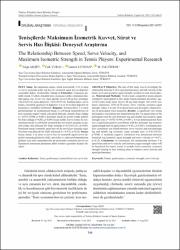| dc.contributor.author | Akşit, Tolga | |
| dc.contributor.author | Vural, Faik | |
| dc.contributor.author | Ceyhan, Gamze | |
| dc.contributor.author | Özkol, Mehmet Zeki | |
| dc.date.accessioned | 2023-10-23T18:53:57Z | |
| dc.date.available | 2023-10-23T18:53:57Z | |
| dc.date.issued | 2021 | en_US |
| dc.identifier.issn | 1308-0938 | |
| dc.identifier.issn | 2146-8885 | |
| dc.identifier.uri | https://hdl.handle.net/11363/6031 | |
| dc.description.abstract | Amaç: Bu çalışmanın amacı, erkek tenisçilerde 5-10 m sürat
ve servis sırasında atılan top hızı ile izometrik squat kuvvet değerleri
arasındaki ilişkiyi incelemektir. Gereç ve Yöntemler: Çalışmaya gönüllü olarak 12 erkek müsabık tenis oyuncusu katıldı (ortalama±standart sapma; yaş: 21±0,5 yıl; vücut ağırlığı: 82,2±1,08 kg; boy uzunluğu:
182,2±0,87cm; tenis deneyimi: 10,91±0,70 yıl). Katılımcıların, servis
hızları, izometrik squat kuvvet değerleri, 5 m ve 10 m sürat değerleri ile
tanımlayıcı özellikleri belirlendi. Bulgular: Katılımcıların 5 m sürat
performansları ile nondominant bacak ve çift bacak izometrik kuvvet
testi arasında negatif yönde çok güçlü düzeyde anlamlı ilişki olduğu
(r=-0,972/-0,944, p<0,001), dominant bacak ile pozitif yönde anlamlı
bir ilişki olduğu (r=0,852, p<0,001) tespit edildi. Servis hızları ile nondominant bacak ve çift bacak izometrik kuvvet testleri arasında ise pozitif yönde orta düzeyde bir ilişki bulundu (r=0,514/0,525, p=0,08).
Dominant bacak izometrik squat kuvveti ile servis hızı arasında negatif yönde orta düzeyde bir ilişki belirlendi (r=-0,472, p=0,12). Sonuç:
Sonuç olarak, 5 m sürat ve servis hızı ile izometrik squat kuvvet değerleri arasında görülen bu ilişki, servis hızı ve sürat performanslarının
gelişimi için tenis antrenörlerinin alt ekstremite izometrik kuvvet çalışmalarını antrenman planlarına dâhil etmeleri açısından faydalı olacaktır. | en_US |
| dc.description.abstract | Objective: The aim of this study was to investigate the
relationship between 5-10 m speed performance, and ball velocity in the
tennis serve and isometric squat strength variables in male tennis players. Material and Methods: Twelve male competitive tennis players
voluntarily participated in this study (mean±standard deviation; age:
21±0.5 years; body mass: 82.2±1.08 kg; body height: 182.2±0.87 cm;
tennis experience: 10.91±0.70 years). Serve velocity, isometric squat
strength values, 5 m and 10 m speed times and descriptive characteristics of participants were measured. Results: A significant very strong
and negative correlation was found between the 5 m speed times of the
participants and the non-dominant leg and double leg isometric squat
strength tests (r=-0.972/-0.944, p<0.001). It was determined that there
was a significant positive correlation with the dominant leg isometric
squat strength and 5m speed times (r=0.852, p<0.001). A moderate positive correlation was found between serve velocity and non-dominant
leg and double leg isometric squat strength tests (r=0.514/0.525,
p=0.08). A moderate negative correlation was determined between
dominant leg isometric squat strength and serve velocity (r=-0.472,
p=0.12). Conclusion: In conclusion, the relationship between 5 m
speed time and serve velocity and isometric squat strength values will
be beneficial for tennis coach to include lower extremity isometric
strength training in their training plans to improve serve velocity and
speed performance. | en_US |
| dc.language.iso | tur | en_US |
| dc.publisher | Türkiye Klinikleri Yayınevi | en_US |
| dc.relation.isversionof | 10.5336/sportsci.2021-83701 | en_US |
| dc.rights | info:eu-repo/semantics/openAccess | en_US |
| dc.rights | Attribution-NonCommercial-NoDerivs 3.0 United States | * |
| dc.rights.uri | http://creativecommons.org/licenses/by-nc-nd/3.0/us/ | * |
| dc.subject | Tenis | en_US |
| dc.subject | Performans | en_US |
| dc.subject | İzometrik kuvvet | en_US |
| dc.subject | Servis hızı | en_US |
| dc.subject | Tennis | en_US |
| dc.subject | Performance | en_US |
| dc.subject | İsometric strength | en_US |
| dc.subject | Serve velocity | en_US |
| dc.title | Tenisçilerde Maksimum İzometrik Kuvvet, Sürat ve Servis Hızı İlişkisi: Deneysel Araştırma | en_US |
| dc.title.alternative | The Relationship Between Speed, Serve Velocity, and Maximum Isometric Strength in Tennis Players: Experimental Research | en_US |
| dc.type | article | en_US |
| dc.relation.ispartof | Türkiye Klinikleri Spor Bilimleri Dergisi | en_US |
| dc.department | Beden Eğitimi ve Spor Yüksekokulu | en_US |
| dc.authorid | https://orcid.org/0000-0003-0223-4508 | en_US |
| dc.authorid | https://orcid.org/0000-0001-6002-8724 | en_US |
| dc.authorid | https://orcid.org/0000-0002-6095-2658 | en_US |
| dc.authorid | https://orcid.org/0000-0003-2418-7036 | en_US |
| dc.identifier.volume | 13 | en_US |
| dc.identifier.issue | 3 | en_US |
| dc.identifier.startpage | 344 | en_US |
| dc.identifier.endpage | 351 | en_US |
| dc.relation.publicationcategory | Makale - Ulusal Hakemli Dergi - Kurum Öğretim Elemanı | en_US |
| dc.contributor.institutionauthor | Ceyhan, Gamze | |



















